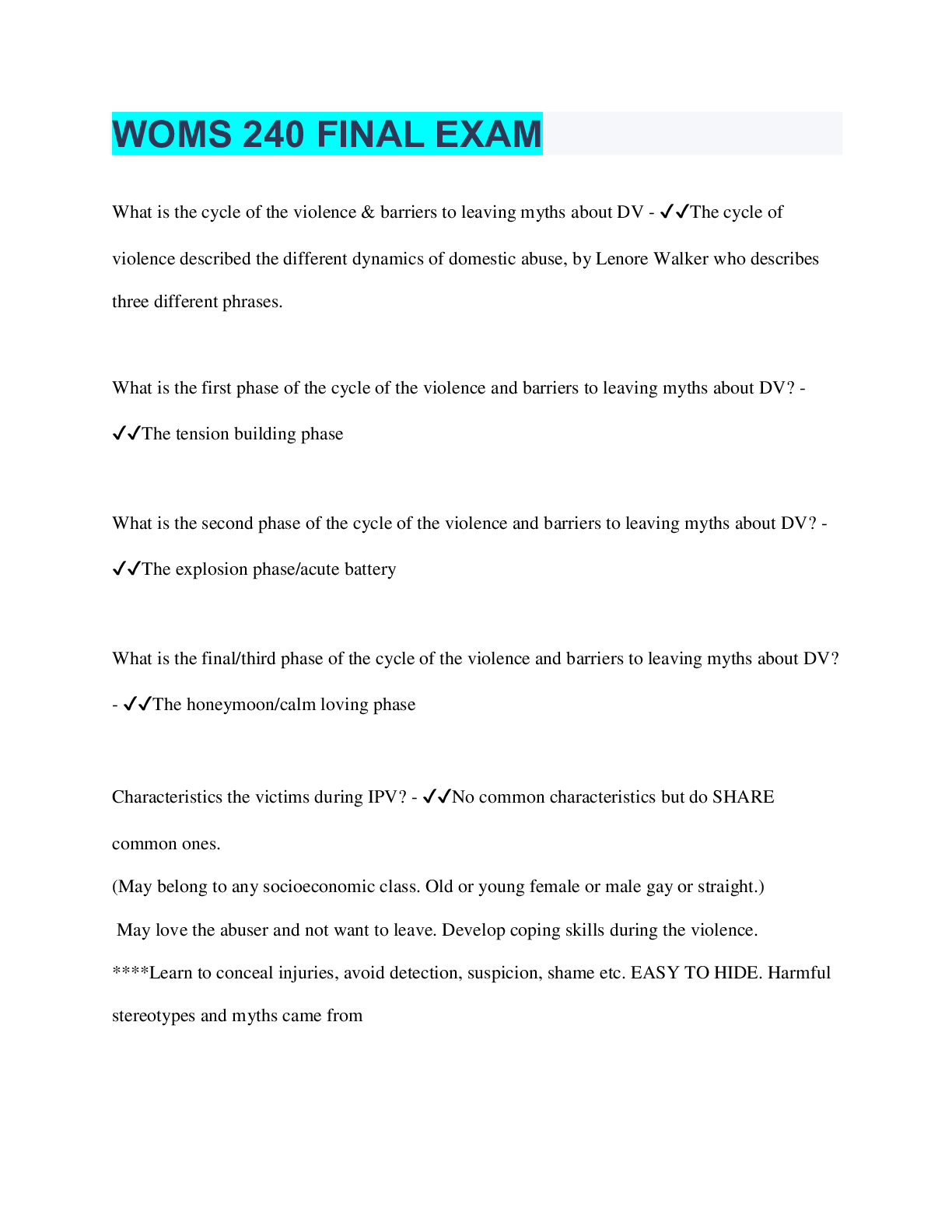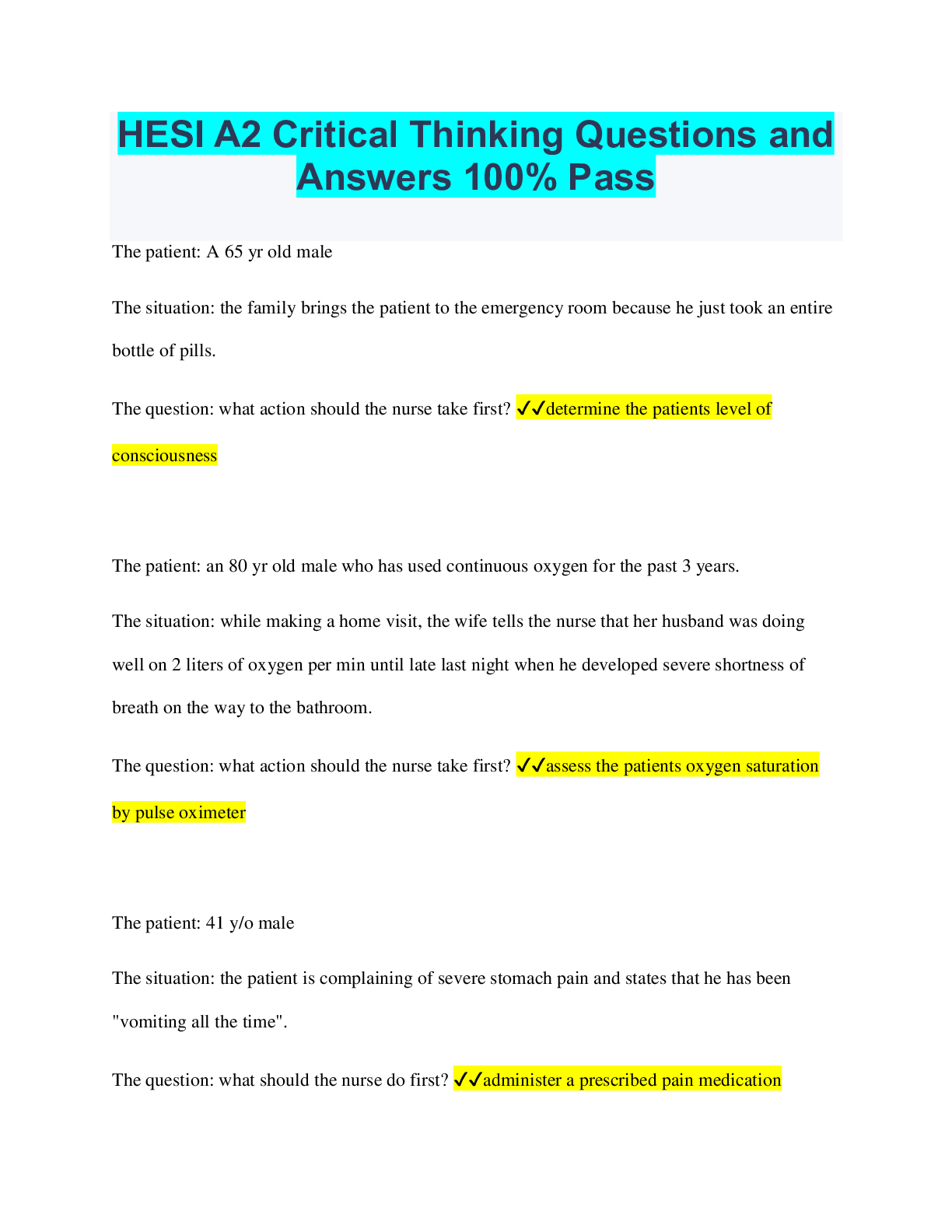Social Sciences > QUESTIONS & ANSWERS > WOMS 240 FINAL EXAM (All)
WOMS 240 FINAL EXAM
Document Content and Description Below
WOMS 240 FINAL EXAM What is the cycle of the violence & barriers to leaving myths about DV - ✔✔The cycle of violence described the different dynamics of domestic abuse, by Lenore Walker who desc... ribes three different phrases. What is the first phase of the cycle of the violence and barriers to leaving myths about DV? - ✔✔The tension building phase What is the second phase of the cycle of the violence and barriers to leaving myths about DV? - ✔✔The explosion phase/acute battery What is the final/third phase of the cycle of the violence and barriers to leaving myths about DV? - ✔✔The honeymoon/calm loving phase Characteristics the victims during IPV? - ✔✔No common characteristics but do SHARE common ones. (May belong to any socioeconomic class. Old or young female or male gay or straight.) May love the abuser and not want to leave. Develop coping skills during the violence. ****Learn to conceal injuries, avoid detection, suspicion, shame etc. EASY TO HIDE. Harmful stereotypes and myths came from Who are the perpetrators during IPV? - ✔✔Same as victims, abusers come from any age, sex, socioeconomic, racial, etc. Perpetrators are NOT always angry and hostile may come off as charming, loveable and may seem like good parent. Often jealous and controlling. *****Abusers differ in patterns of abuse and levels of aggression/danger They share a behavioral profile "an ongoing pattern of coercive control w/ intimidation, psych, and mental abuse. THEY MAY TRY TO DENY ABUSE, THEY ALSO CAN POSESS POSITIVE QUALITIES What is the impact on the family during IPV? - ✔✔Abusers use children as a way to control victims, children often see assault results in their own trauma, older child may be hurt trying to protect, children indirectly hurt when violent things happen to victim, academic and emotional problems, use of violence as problem solving, fear of abandonment, guilt for not stopping the abuse, headaches and stomachaches Characteristics of perpetrators during IPV? - ✔✔Exposure to violence in family origin, self image is poor, deficient verbal skills, emotionally inexpressive, traditionalists (believe in male supremacy and norms of males as heads of house), social isolation, authoritarian personalities, psychopathology, easily threatened masculinity, need for power Barriers to leaving IPV? - ✔✔Fear, Threaten sole custody, make child abuse allegations/threats/kidnap, isolation (use to control victims), guilt and shame, peer or family collusion (other people's denial), Hope in the abuser, Poor community service, emotional impairment, financial dependence Seasaw coupling - ✔✔Moving from honeymoon to assault and back over and over what are the similarities hetero and homosexual partner abuse? - ✔✔The types of violence are similar. Physical, sexual, economic, control, and emotional abuse. Also equally skeptical to report. what are the differences between hetero and homosexual partner abuse? - ✔✔Homophobia/Transphobia, may threaten to tell family and friends of victim that they are homosexual and out them when not wanting to be. Use internalized transphobia/homophobia, may use stereotypes to show victim is useless to report. legal & court history of DV - ✔✔Supreme court case Thurman v Torrington which was the first case to allow civil rights suit for alleged and equal protection violation. Landmark case made police liable for failing to respond to the calls and led to adoption of pro arrest policies across country. Torrington stabbed 17 times Thurman and police officers did nothing. Older court history - ✔✔Women's movement in 1970 challenges DV, in 1974 first women's shelter, in 1976 oregon first state to have arrest in DV cases, 1980's saw criminalization of DV, 1983 Task Force, 1985 Surgeon Gen Everett named domes [Show More]
Last updated: 1 year ago
Preview 1 out of 16 pages

Buy this document to get the full access instantly
Instant Download Access after purchase
Buy NowInstant download
We Accept:

Reviews( 0 )
$10.00
Can't find what you want? Try our AI powered Search
Document information
Connected school, study & course
About the document
Uploaded On
Jul 29, 2023
Number of pages
16
Written in
Additional information
This document has been written for:
Uploaded
Jul 29, 2023
Downloads
0
Views
88


























